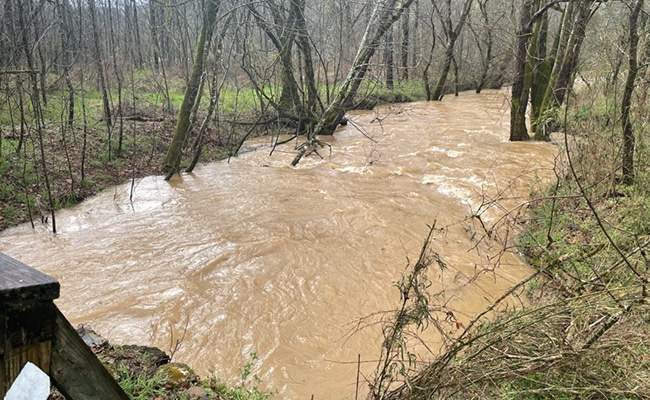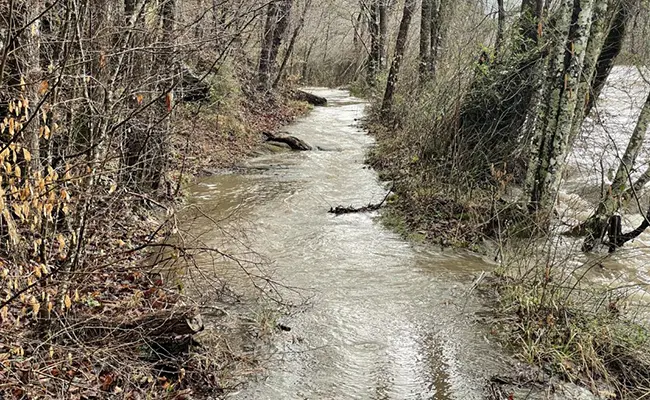Water crossings on long-distance trails have been some of my most dangerous experiences. The one below is probably one I should not have attempted.
The roar grew louder as the trail began descending from the side of the mountain. This had been a day of roaring water as I traveled alongside the raging Hiawassee River, walking under waterfalls and picking my way across small, turbulent streams.
In several sections, the Hiawassee had overflowed its banks, and I was basically in the river, which led me to consider camping early and waiting for water levels to drop. But the pull of more miles was strong on the trails, and I continued hiking.
Over the roar, I heard voices, and as I peered through the trees, I saw frothy white water and colored clothing. As I approached angry Loss Creek, a hiker walked towards me, looking a little anxious. He asked me if I was going to cross and said his wife and friend were trying to cross.
I walked to the edge of the creek and looked down. “Holy Crap,” I muttered. The stream, described as “a rockhopper” in my Guide, was about 20 yards across and had a series of brown swirling angry rapids. There was no way I could cross. On the other side were two other hikers pacing up and down through the woods, trying to find a safe way across.
The hiker on my side had shimmied across a large fallen tree. The tree lay at an angle across the creek, half of it out over a waterfall where a pile of debris had gathered. Neither side touched the bank, but the end on our side was close, and you could wade out and climb up on the other side. The dark wood looked wet and slick.
Eventually, the other male hiker started swimming in what looked like a less turbulent area just ahead of the log jam and waterfall. Halfway across, the current grabbed him, and he thrashed, barely making the shore before tumbling over the Falls. His eyes were huge as he thrashed through the water to the coast.
After he climbed to shore, both guys went down to try and stabilize the tree so the first hiker’s wife could shimmy across. She was tiny, and the tree swung back and forth as she crossed. The large tree was perched on the edge of the Falls like a giant pendulum ready to roll over.
I probably weighed twice what she did with my pack. I was swimming.
Initially, I had planned to camp and try to cross the following day in hopes the water would calm down and lower a little. There were other hikers here now, though, and I would much rather cross with others to help if needed.
Lowering myself into the waist-deep water, I pushed my buoyant pack out before I reached my toes and began swimming hard. The pack slowed, and I started pulling it, but that only lasted a few strokes before the current grabbed me and yanked me underwater. The water had looked fast but not this strong. I let the pack go and swam as hard as I could, glancing over to see the log and waterfall approaching quickly.
I told myself not to panic and swam harder, with my clothes and shoes dragging me down. Over the roar of the water, I could faintly hear the yells of Frisbee, Stubs, and Middle Brother urging me on. At least, I think I could.
Suddenly the current lessened, and just before the log, I could break loose and swim hard. I felt rocks under my shoes and pushed hard, leaving the current and collapsing to my knees in the quieter waters near shore.
I paused for a minute and turned to see my pack wedged against the tree. Holding onto the large tree, I waded out and grabbed the waist strap, dragging the now 100-pound water-logged backpack back to shore.
The hikers on the other side cheered as I dragged my soaked, wet rat self ashore, and I turned and gave a slight bow before waving goodbye. They could not see the tears of relief in my eyes.
It was late afternoon, and temperatures were dropping fast. The water had been frigid, and I needed to MOVE. I hiked About a half mile, fast, allowing my clothes and hair to dry a little. Then I stopped to assess the water damage to the pack.
The backpack itself was utterly waterlogged. I swear it felt as if it weighed a minimum of 50 pounds! I learned that against a river well, sealed freezer bags and gallon bags are NOT waterproof. Hyperlite Pods are also not waterproof, and finally, a compactor bag is only about 50 percent resistant to a raging river.

Basically, the only thing that stayed dry was my Outdoor Research (OR) food bag. I can always count on OR.
I needed to dry out. It looked like it was going to start raining again and getting cold. I pulled out my Guide and saw a state highway in about 4 miles. I, of course, had no signal, so I climbed up to the ridge and called a small motel that agreed to pick me up at the next road crossing.

If I could do it all over, I would not try that crossing again, regardless of whether other hikers were there. I should have waited another day or two for water levels to drop. There were other small streams before that one that was moving fast, too, although none like that stream.
Too many things could have gone wrong, and it is not worth the risk. I’m not a young whipper snapper anymore. I have definitely hiked enough to know when to take a calculated risk and when not to. Risk is part of long-distance hiking, but not dumb risks. I love a good adventure as much as anyone, but that was stupid.


